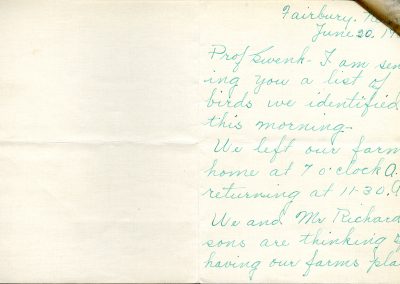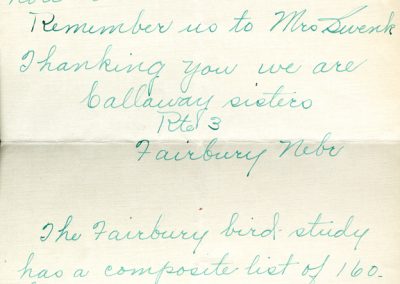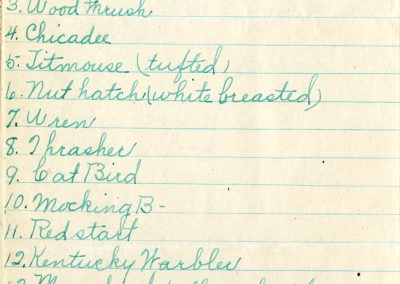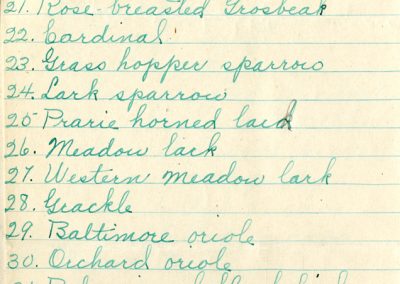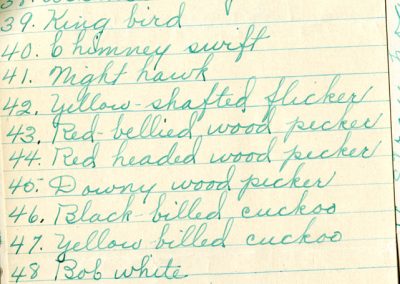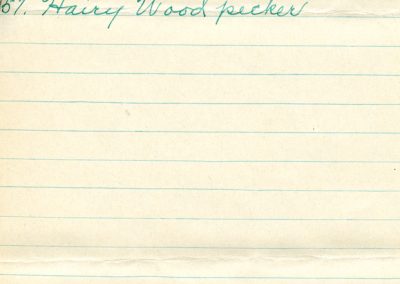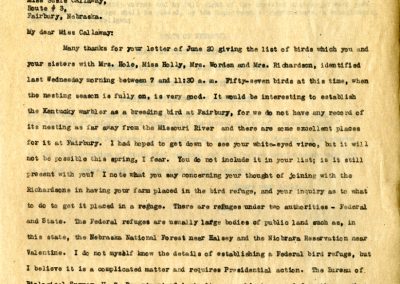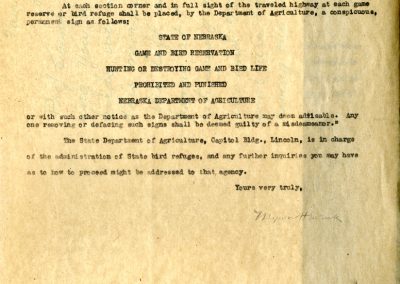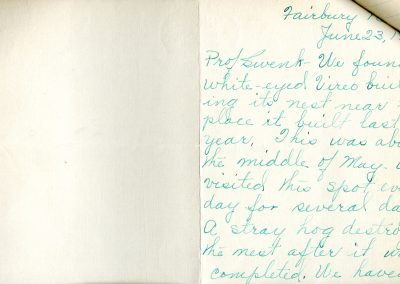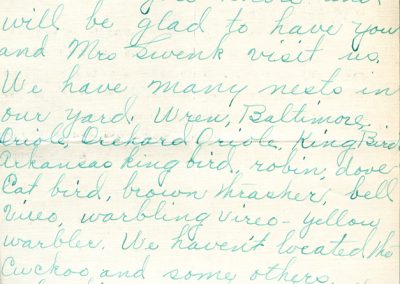Great Nebraska
Naturalists and ScientistsNebraska Ornithologists’ Union
Letters, 1923, June
1920, June 20
Fairbury, Ne June 20, 19
Prof Swenk – I am sending you a list of birds we identified this morning. We left our farm home at 7 o’clock A.M. returning at 11:30 A.M. We and Mr. Richardsons are thinking of having our farms placed
The Fairbury bird study has composite list of 160 birds Susie Callaway
1 Blue bird 2. Robin 3. Wood thrush 4. Chicadee 5. Titmouse (tufted) 6. Nuthatch (white breasted) 7. Wren 8. Thrasher 9. Cat Bird 10. Mocking B. 11. Red start 12. Kentucky Warbler 13. Maryland yellow throat 14. Bell Vireo 15. Warbling Vireo 16. Red-eye Vireo 17. Shrike 18. Bank Swallow
1923, June 22
June 22, 1923.
Miss Susie Callaway, Route # 3, Fairbury, Nebraska.
My dear Miss Callaway: Many thanks for your letter of June 20 giving the list of birds which you and your sisters with Mrs. Hole, Miss Holly, Mrs. Worden and Mrs. Richardson, identified last Wednesday morning between 7 and 11:30 a. m. Fifty-seven birds at this time, when the nesting season is fully on, is very good. It would be interesting to establish the Kentucky warbler as a breeding bird at Fairbury, for we do not have any record of its nesting as far away from the Missouri River and there are some excellent places for it at Fairbury. I had hoped to get down to see your white-eyed vireo, but it will not be possible this spring, I fear. You do not include it in your list; is it still present with you? I note what you say concerning your thought of joining with the Richardsons in having your farm placed in the bird refuge, and your inquiry as to what to do to get it placed in a refuge. There are refuges under two authorities – Federal and State. The Federal refuges are usually large bodies of public land such as, in this state, the Nebraska National Forest near Halsey and the Niobrara Reservation near Valentine. I do not myself know the details of establishing a Federal bird refuge, but I believe it is a complicated matter and requires Presidential action. The Bureau of Biological Survey, U. S. Department of Agriculture, could give you information on that point if you care to write them. The small bird refuges in Nebraska are established under the State law passed in 1921. I will quote for you the sections in the law relating to State game and bird serves:
“Every school section and other tract of educational land, within the state, whose title is vested in the State of Nebraska, is hereby declared to be a game reserve and bird refuge. Other game reserves and bird refuge. Other game reserves and bird
refuges or reservations may be established by the Department of Agriculture in any county where they shall be deemed necessary for the protection and propagation of game, or as a refuge or sanctuary for song and insectivorous birds. The land for such reserve or reservation established by the Department of Agriculture, shall be leased at a nominal rental one dollar per year for each parcel. On every reserve or bird refuge the department may have planted suitable grain or other food for birds and game, not to exceed five acres for each 640 acre reservation, and for each such parcel so planted the department may, if required to do so, pay a rental not to exceed the usual rent of similar land in the vicinity or locality.
At each section corner and in full sight of the traveled highway at each game reserve or bird refuge shall be placed, by the Department of Agriculture, a conspicuous, permanent sign as follows:
STATE OF NEBRASKA GAME AND BIRD RESERVATION HUNTING OR DESTROYING GAME AND BIRD LIFE PROHIBITED AND PUNISHED NEBRASKA DEPARTMENT OF AGRICULTURE
or with such other notice as the Department of Agriculture may deem admissible. Any one removing or defacing such signs shall be deemed guilty of a misdemeanor.”
The State Department of Agriculture, Capitol Bldg., Lincoln, is in charge of the administration of Sate bird refuges, and any further inquiries you may have as to how to proceed might be addressed to that agency. Yours very truly,
1923, June 23
Fairbury June 23, 1
Prof Swenk – We found a white-eyed Vireo building its nest near the place it built last year. This was about the middle of May. We visited the spot every day for several days. A stray dog destroyed the nest after it was completed. We haven’t
1923, June 25
June 23, 1923.
Miss Susie Callaway, Route #3, Fairbury, Nebraska.
My dear Miss
Callaway: Thank you for the information regarding the nesting of the white-eyed vireo at
Fairbury this year. If you succeed in locating its nest either this year or next year I would
appreciate your letting us know about it so that, if possible, I can see it. This bird is as a
rule so closely confined to the Missouri river region that its nesting as far away as Fairbury
is something or a record. Assuring you of our appreciation of your courteous invitation, I am
Yours very truly, Myron Swenk Secretary-Treasurer, N. O. U.
